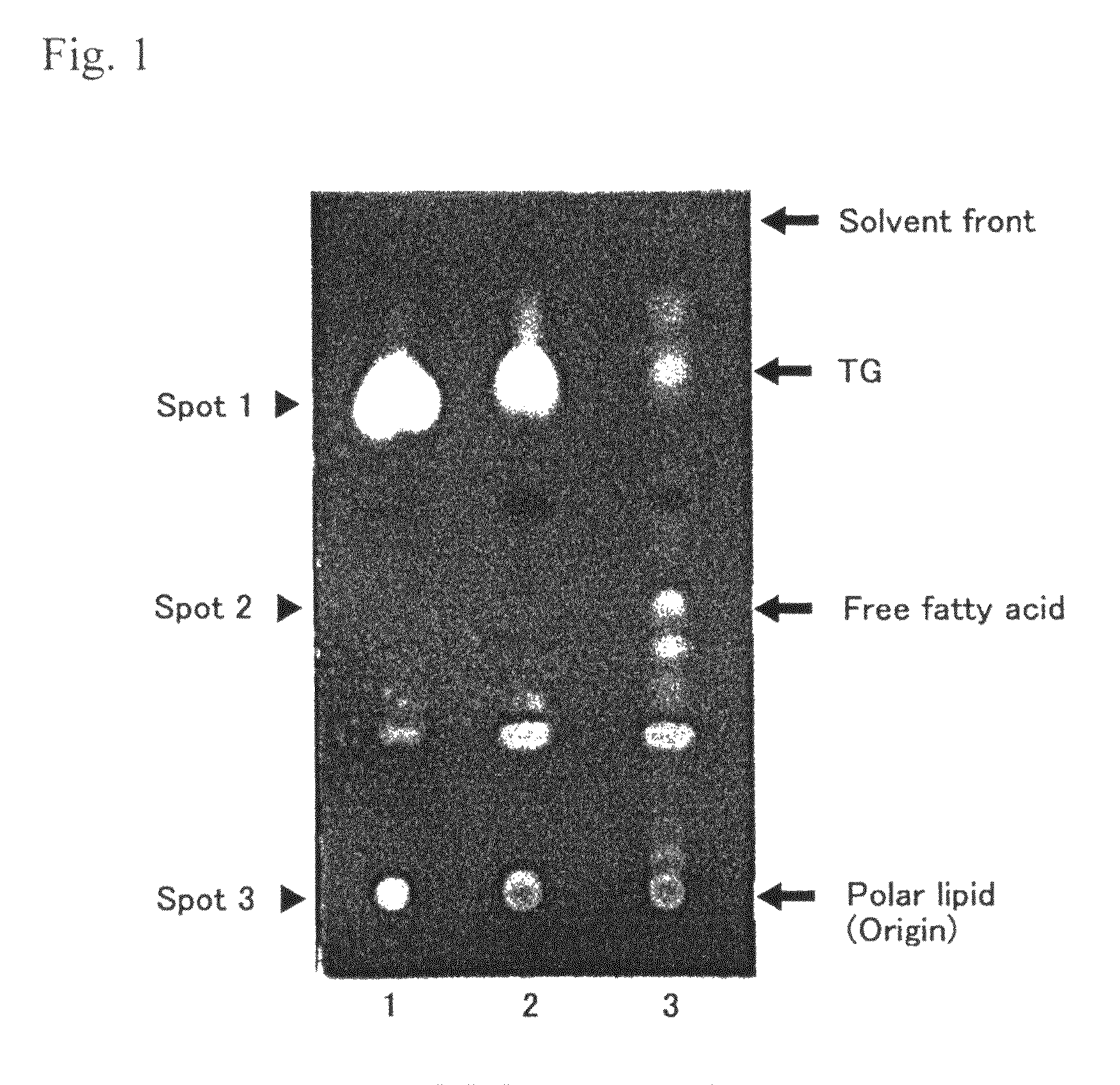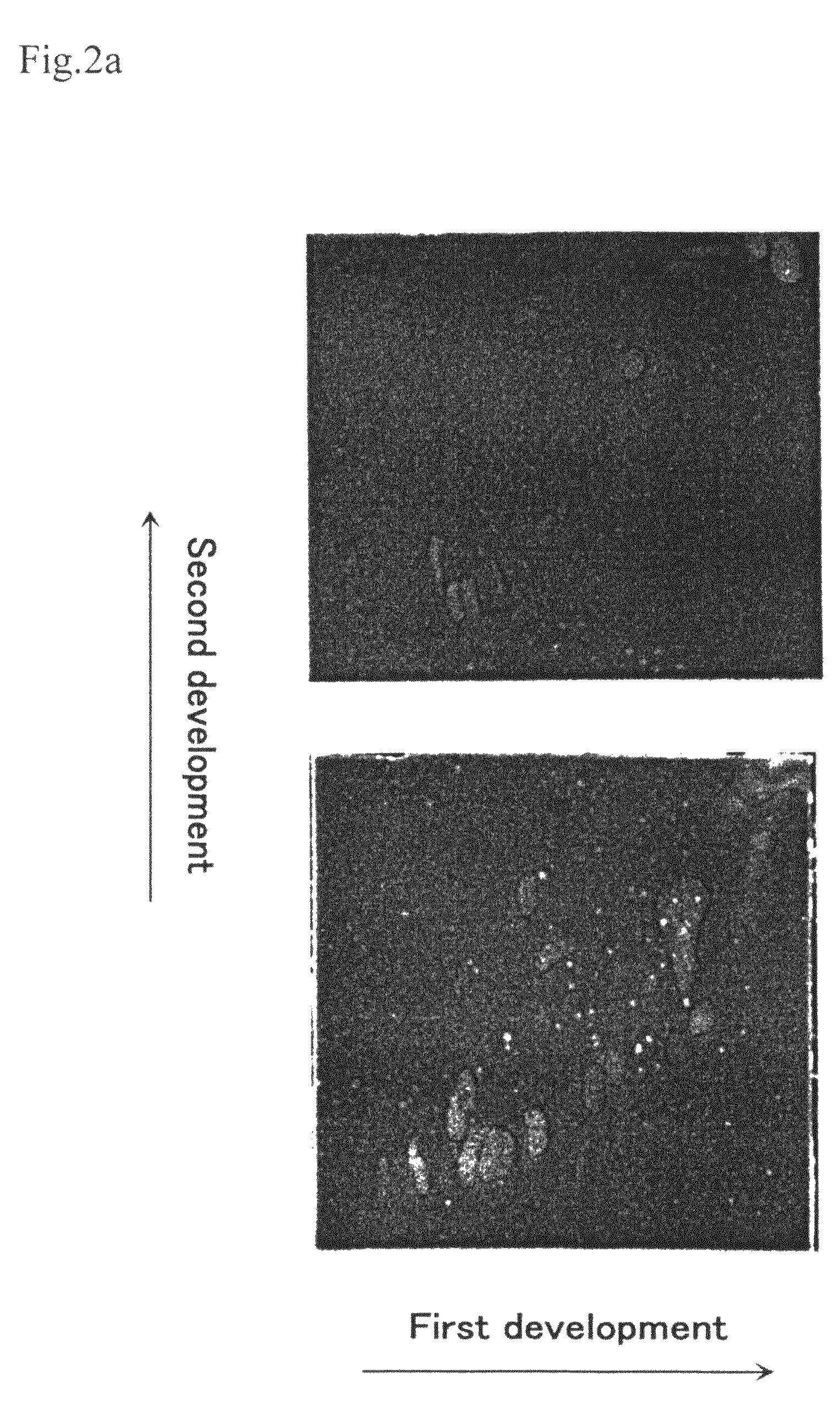Method for production of DHA-containing phospholipid through microbial fermentation
- Summary
- Abstract
- Description
- Claims
- Application Information
AI Technical Summary
Benefits of technology
Problems solved by technology
Method used
Image
Examples
example 1
[0055]1 platinum loop (approximately 1 mg) of labyrinthulean strain 12B cells preserved in an agar plate culture medium containing By+ culture medium (0.1% peptone, 0.1% yeast extract, 0.5% glucose, 50% seawater and 1.0% agar) was inoculated into 10 mL of F culture medium (50% seawater, 1% peptone, 1% yeast extract and 8% glucose), and cultured at 30° C. for 72 hours. The turbidity of culture solution after culturing (OD600) was about 36. 4 mL of the culture solution was inoculated into 25 mL of Z1 culture medium (culture medium in which glucose is removed from F culture medium) and cultured at 30° C. for 48 hours. During the culturing, OD600 of the culture solution was measured as time was elapsed, and dry cell weight after culturing, weight of total lipids extracted from dry cells, TG volume in the total lipids, phosphorus volume, proportion of phospholipid weight calculated from the phosphorus volume to the total lipids, and DHA content in fatty acids from the total lipids were c...
example 2
[0060]Like in Example 1, 4 mL of culture solution of F culture medium, in which labyrinthulean strain 12B cells were cultured, was inoculated into 25 ml of Z2 culture medium containing 2% peptone and 2% yeast extract, and 25 mL of Z4 culture medium containing 4% peptone and 4% yeast extract, and cultured at 30° C. for 48 hours. The turbidity after culturing, dry weight of collected cells, weight of total lipids extracted from dry cells, phosphorus volume in the total lipids, phospholipid weight calculated from the phosphorus volume, their proportions and DHA content were determined (see Table 1). The phospholipids were quantified by measuring inorganic phosphorus volume using phosphatidyl serine (Sigma) as a standard preparation.
[0061]Consequently, by increasing the contents of peptone and yeast extract, the yield of labyrinthulean strain 12B cells rises (235 mg in Z1 culture medium, 243 mg in Z2 culture medium and 339 mg in Z4 culture medium). In Z4 culture medium, a cell yield was...
example 3
[0064]Culture mediums, in which 1 mM K2PO4, 1 mM K2PO4+1 mM serine, 1 mM K2PO4+1 mM ethanolamine were added to Z1 culture medium (hereinafter called Z1p, Z1ps and Z1pa), were prepared. By culturing like in Example 1, the turbidity after culturing, dry cell weight of cells collected, weight of total lipids extracted from dry cells, phosphorus volume in the total lipids, phospholipid weight calculated from phosphorus volume, their proportions and DHA content were determined.
[0065]As a result, phospholipid weight was increased in Z1ps (15.2 mg). From the results, it was confirmed that by adding inorganic phosphorus and amino acid to each culture medium, volume of phospholipid produced can be increased.
[0066]Table 1 shows analytical results of the above Example 1 to 3.
[0067]
TABLE 1Effects of medium composition and cultivation time on cell growth, phospholipid contentand DHA content of labyrinthulean strain 12BMediumFZ1Z1Z1Z2Z4Z1Z1Z1Glucose+a−a−−−−−−−K2HPO4−−−−−−+++Ethanolamine−+−Serine−...
PUM
 Login to View More
Login to View More Abstract
Description
Claims
Application Information
 Login to View More
Login to View More - R&D
- Intellectual Property
- Life Sciences
- Materials
- Tech Scout
- Unparalleled Data Quality
- Higher Quality Content
- 60% Fewer Hallucinations
Browse by: Latest US Patents, China's latest patents, Technical Efficacy Thesaurus, Application Domain, Technology Topic, Popular Technical Reports.
© 2025 PatSnap. All rights reserved.Legal|Privacy policy|Modern Slavery Act Transparency Statement|Sitemap|About US| Contact US: help@patsnap.com



